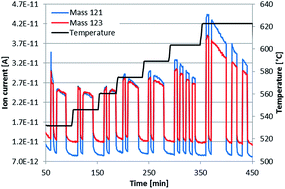Study of thermal stability of p-type skutterudites DD0.7Fe3CoSb12 by Knudsen effusion mass spectrometry
Abstract
The temperature and phase stability of p-type skutterudites, DD0.7Fe3CoSb12, manufactured via various preparation techniques, all exhibiting a high ZT-level, have been studied by means of thermal analysis and Knudsen effusion mass spectrometry. The results from phase transformation measurements and characteristics of the evaporation of antimony, as the volatile element, supported by microstructure observations and by diffusion profiles are summarized and discussed in view of a full understanding of the degradation processes and knowledge of the long term operation stability of the bulk and nano-structured thermoelectrics studied. It was found out that the antimony evaporation is a complex diffusion kinetic process resulting in a stable Sb level dependent on the preparation route. The studied p-type skutterudites, DD0.7Fe3CoSb12, have proven their long term stability in thermoelectric devices at a maximum operation temperature of 600 °C. Complementary data on the structural, physical and mechanical properties of the materials are presented as well.



 Please wait while we load your content...
Please wait while we load your content...